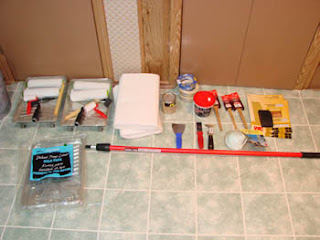- Start off by taping all edges of your room that you don't want painted. This will usually include the base boards, crown molding, windows and any additional fixtures or outlets on the wall. It's easier to simply remove the face plates on your wall outlets.
- Cover the ground of the room you're painting with plastic sheeting so you don't get paint on your flooring. Modern paints have very concentrated and potent dyes that can be a nightmare to extract from carpet or other porous surfaces.
- Make sure your paint is mixed well and then pour it into your paint tray that you plan on using with your roller. Only pour enough paint into the tray so that there is still enough space on the ramp to roll off the excess paint before moving over to the wall.
- Make sure the room you're in is well ventilated. Paint fumes can make you sick so leaving a window open and having a high volume fan move air around is highly recommended.
- If this is the first time you've painted a wall you will initially want to be very careful to apply paint in a very even and uniform fashion. If you are painting a solid color, especially white, you will quickly realize that paint is VERY forgiving when it dries. The depth of color that is added by the moisture in the paint fades away into a very even finish once the paint dries. My recommendation is to do your best to apply an even coat of paint and just keep moving on to the next parts of your room.
- Get as close to the edges with your roller as you can. It takes much longer to paint with a brush than it does with your roller so you'll want to save time and just be careful with your roller.
- After you've covered the majority of square footage with your roller you'll have to touch up your edges with a brush. Again, paint is very forgiving so you can be pretty aggressive. You're not painting canvas, so just go for good, even coverage.
- Let your paint dry partially before removing your tape. You can check the side of your paint can for normal dry times. There should be a dry time for re-painting and a complete dry time.
- If you are covering a darker color with a fresh coat of lighter colored paint you will usually have to go over your first coat with a second. Sometimes you can get away with one coat if you prime the wall first or use a quality paint with primer mixed in.
After you've pulled your tape and re-attached your face plates you'll be amazed at how much better your room looks with a simple coat of paint.

No comments:
Post a Comment